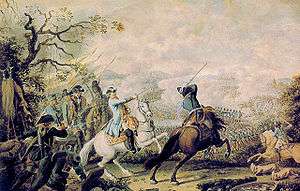Battle of Kagul
| Battle of Cahul | |||||||
|---|---|---|---|---|---|---|---|
 Battle of Kagul, by Daniel Chodowiecki | |||||||
| |||||||
| Belligerents | |||||||
|
|
Crimean Khanate | ||||||
| Commanders and leaders | |||||||
| Pyotr Rumyantsev | Ivazzade Halil Pasha | ||||||
| Strength | |||||||
| 35,000[1]-42,000,[2] 118 guns[3] |
Ottoman: 75,000,[2] of them 50,000 infantry Tatar: 80,000-100,000 cavalry[3] 150,000-175,000 total | ||||||
| Casualties and losses | |||||||
| ca 1,000[1]-1,500[4] killed and wounded | 20,000 killed, wounded and captured[1] | ||||||
The Battle of Kagul[1] (Russian: Сражение при Кагуле, Turkish language:Kartal Ovasi Muharebesi) was the most important land battle of the Russo-Turkish War, 1768-1774 and one of the largest battles of the 18th century. It was fought on 1 August 1770 (21 July at Julian Calendar), in Moldavia, near the village of Frumoasa (now Cahul, Moldova), just a fortnight after the Russian victory at Larga.
Under contribution of Pyotr Melissino, the Russian commander Pyotr Rumyantsev arranged his army of 40,000 soldiers in solid squares and surprisingly chose to go on the offensive against the allied forces of the Khanate of Crimea and the Ottoman Empire, which consisted of 30,000 Ottoman infantry and 45,000 Ottoman cavalry. About 80,000 Crimean Tatar cavalry were deployed within 20 km from the battlefield but they did not engage in battle.
The comparatively small Russian army assaulted the Ottomans and put them to flight. The Russian casualties were 1,000, while casualties on the Ottoman side amounted to over 20,000 soldiers killed and wounded. In the wake of this victory, the Russians captured 130 Ottoman cannons and overran all major fortresses in the region - İsmail (now Izmail), Kilya (now Kilia), Akkerman (now Bilhorod-Dnistrovskyi), İbrail (now Brăila), İsakça (now Isaccea), and Bender.
In commemoration of the victory, Catherine II of Russia ordered the Kagul Obelisk to be erected in Tsarskoe Selo, while Frederick II of Prussia sent to Rumyantsev a congratulatory letter in which he compared the Russian victory to the deeds of the Ancient Romans.
On the same day four years later, Russian and Ottoman empires signed the Treaty of Küçük Kaynarca ending the war.
Sources
- 1 2 3 4 Archer, Christon (2002). World History of Warfare. U of Nebraska Press. p. 444. ISBN 9780803244238.
- 1 2 Stone, David (2006). A Military History of Russia. Greenwood Publishing Group. p. 80. ISBN 0-275-98502-4.
- 1 2 (Russian) km.ru: "The battle of Kagul" Archived January 13, 2011, at the Wayback Machine.
- ↑ СРАЖЕНИЕ НА РЕКЕ КАГУЛ, "Cyrill and Methodius" Encyclopedia (Russian)
 Media related to Battle of Kagul at Wikimedia Commons
Media related to Battle of Kagul at Wikimedia Commons
Coordinates: 45°55′N 28°11′E / 45.917°N 28.183°E